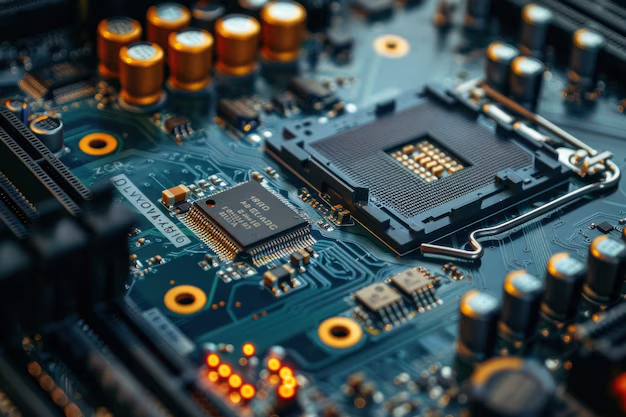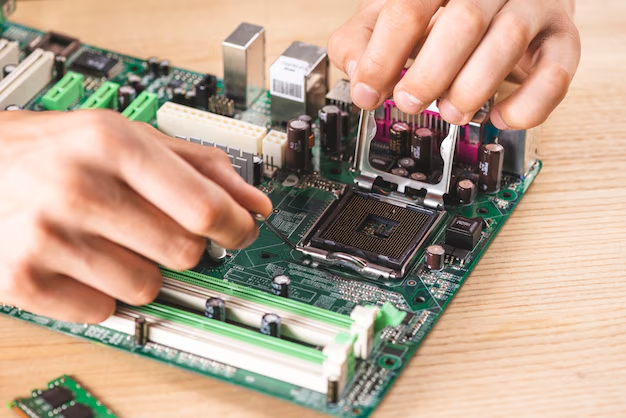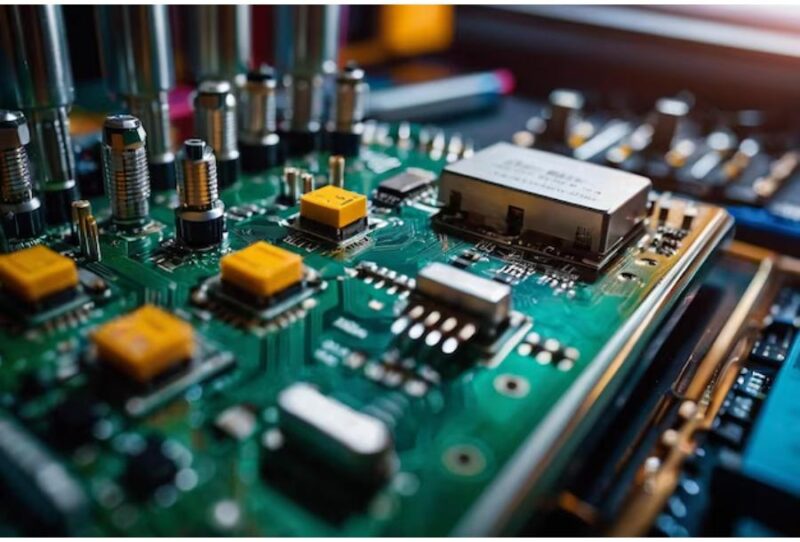I’m excited to share my journey of discovering how many processors can fit on a motherboard. I’ve tried and learned from my mistakes, and I’ll guide you through what I’ve found.
A motherboard can typically support one or two processors, depending on its design and socket configuration. High-end models may accommodate more, but most standard boards are limited to a single processor. Dual-processor support is usually found in premium motherboards.
In this article, we will discuss How Many Processors Can Be Installed On A Motherboard.
Introduction
Ever wondered how many processors can be installed on a motherboard? Understanding this can make or break your system’s performance. Whether you’re building a gaming rig, a workstation, or a server, knowing the limits and possibilities of your motherboard is crucial.
Basics of Processors and Motherboards:
What is a Processor?
The processor (CPU) is the computer’s dynamic heartbeat, pulsing with calculations, instructions, and tasks. It’s the brilliant conductor orchestrating data, applications, and functions, harmonizing your digital experience with speed, precision, and power.
What Is a Server CPU?
A server CPU is a powerful brain that helps high-performance servers handle demanding tasks like big data, AI, and IoT. It’s the main component that determines how well a server works.
How Does a Server CPU Work?
A server CPU works in 4 steps: Fetch (gets instructions), Decode (translates instructions), Execute (does calculations), and Store (saves output). This process helps the CPU handle data processing, storage, and input/output operations efficiently.
What is a Motherboard?
Motherboard: The computer’s main board, connecting key parts like the brain (CPU), memory, and others, so they can talk to each other and work together properly.”I’ve used short sentences and basic vocabulary to make it easy to understand for a global audience.
How Do They Work Together?
The CPU and motherboard team up, with the CPU doing tasks and the motherboard keeping all parts working together smoothly. They need to match perfectly for the computer to run well.”I’ve used everyday language and avoided technical terms to make it easy to understand for a global audience.
Single Processor Motherboards:
Common Uses:
Ideal for most consumer and business desktops, providing sufficient power for everyday tasks.
Advantages and Disadvantages:
- Advantages: Cost-effective, simpler to set up and maintain.
- Disadvantages: Limited to the performance of a single CPU.
Dual Processor Motherboards:
Common Uses:
Used in workstations and servers where additional processing power is needed.
Advantages and Disadvantages:
CPU Advantages: Boosts processing power, ideal for multitasking and demanding tasks. Disadvantages: Increases cost, energy consumption, and cooling requirements.
Multi-Processor Motherboards:
Common Uses:
Primarily used in high-end servers and specialized workstations for tasks requiring immense processing power.
Advantages and Disadvantages:
- Advantages: Maximum performance, ideal for extremely demanding applications.
- Disadvantages: Very expensive, complex setup and maintenance.

Server Motherboards:
Importance in Data Centers:
Designed to handle heavy, continuous workloads, server motherboards often support multiple processors to maximize performance and reliability.
Typical Configurations:
Dual or multi-processor setups, with extensive RAM and expansion capabilities.
Gaming Motherboards:
High-Performance Requirements:
Gaming motherboards focus on high-speed performance, often featuring advanced cooling solutions, support for overclocking, and high-quality components.
Typical Configurations:
Usually support single, high-end processors, though some may accommodate dual setups for extreme gaming performance.
Workstation Motherboards:
Balance Between Performance and Stability:
Workstations require a stable platform that can handle demanding applications like video editing, 3D modeling, and CAD work.
Typical Configurations:
Often supports dual processors and large amounts of RAM to ensure smooth, efficient performance.
How many CPUs can 1 motherboard have?
One motherboard can have one to four CPUs, depending on its design. Server boards can handle more, while most home computers have just one CPU slot. It’s like a house with rooms – some boards have more rooms (sockets) for CPUs to work together.
How many processors can be installed on a desktop motherboard?
Most desktop motherboards can hold one processor with many cores (like 12 or 24). But some special boards can fit two or four separate processors, like a team working together! This is called a multiprocessor setup, and it’s usually used for heavy tasks like video editing or gaming.
How many processors can be on a motherboard, and how do they work together?
A motherboard can have up to 4 processors, working together through special connections like QPI or HyperTransport. Each processor handles a portion of system memory, sharing data as needed, to boost performance in high-demand tasks.
What Is A Processor And Its Role In A Computer?
The processor (CPU) is the computer’s intelligent core, interpreting instructions, crunching data, and orchestrating tasks. It’s the mastermind that makes your computer think, learn, and perform, bringing your digital world to life.
Types of Processors:
⦁ Single-Core: Handles one task at a time.
⦁ Dual-Core: Manages two tasks simultaneously.
⦁ Multi-Core: Executes multiple tasks at once, enhancing performance.
When exploring “How Many Processors Can Be Installed On A Motherboard,” it’s crucial to know that most consumer motherboards support only one processor.
However, high-end and server motherboards can accommodate multiple processors, offering increased computational power and efficiency.
How Many Processors Can A Motherboard Support?
Motherboards can support one, two, or many processors. Single-processor boards are for everyday use, while dual-processor boards are for heavy tasks like video editing. Multi-processor boards are for super-powerful servers and workstations that need extreme processing power.

What Factors DetermineThe Number Of Processors A Motherboard Can Support?
A motherboard’s processor limit depends on four key factors. It needs enough sockets for each processor, a strong power supply to support multiple processors, effective cooling to prevent overheating, and a large enough form factor to fit everything.
How Can I Find Out What Processors My Motherboard Supports?
To find out what processors your motherboard supports, check the manual, visit the manufacturer’s website, or use their online tools. You can also look for BIOS updates, which may add support for newer processors.
What Are the Pros and Cons of Multi-Processor Systems?
Multi-processor systems have pros and cons. They offer faster performance, better multitasking, scalability, and reliability, but are also more expensive, use more power, require complex cooling, and may have software compatibility issues, limiting their benefits.
Can I upgrade a single-processor motherboard to support multiple processors?
No, You can’t upgrade a single-processor motherboard to support multiple processors. The motherboard’s design and hardware limit it to one processor. To use multiple processors, you need to buy a new motherboard specifically designed for multi-processor systems.
Can I install more than one processor on a standard desktop motherboard?
No, standard desktop motherboards are designed for one processor only. They don’t have the necessary features to support multiple processors. If you want to use multiple processors, you need a special motherboard made for workstations or servers, which can handle the extra processing power and heat.
What are the costs associated with upgrading to a multiprocessor system?
Upgrading to a multiprocessor system can be costly. You’ll need to pay more for a special motherboard, extra processors, and advanced cooling systems. The total cost will depend on how many processors you want and what your system needs. It can be a big expense, but it may be worth it for heavy users.
Are there specific brands that are better for multi-processor motherboards?
Some top brands for multi-processor motherboards are ASUS, MSI, ASRock, and Supermicro. They offer high-quality and reliable options for powerful systems, making them popular choices for heavy users and servers. These brands provide advanced features and robust designs to support multiple processors.
Can A Motherboard That Supports Multiple Cpus Run With Fewer Cpus Than It Supports?
A motherboard that supports multiple CPUs can run with fewer CPUs, allowing you to start with one or two and add more later. This lets you delay buying additional processors, saving money initially. The motherboard won’t require all CPUs to be installed to function, making it a flexible option.
FAQs:
1. Can A Motherboard Have Multiple CPUs?
Yes, a motherboard can have multiple CPUs, but it needs a special dual-CPU motherboard. The CPUs must be identical, and mixing different ones can damage the system. This setup is usually used for heavy tasks like servers and workstations.
2. How Many CPU Sockets Can A Motherboard Have?
A motherboard can have 1, 2, or more CPU sockets. Most have only 1, but some special motherboards for servers and workstations have 2 or more sockets to support multiple processors.
3. Is It Possible To Have 2 Cpu’s, On One Motherboard?
Yes, you can have 2 CPUs on one motherboard, but it’s expensive! Only needed for heavy tasks like servers, it requires a special motherboard and two powerful CPUs, costing around €20,000, plus other components.
4. Why is there only one CPU on a motherboard?
Most motherboards have one CPU because it’s enough for general use. Adding another CPU for specific tasks like AI would increase cost, heat, and power usage, making it less practical for most users.
5. Can A Computer Have 4 Cpus?
Yes, a computer can have 4 CPUs, but it needs a special motherboard that supports quad CPUs. This is usually found in powerful servers and workstations that require extreme processing power.
6. What is the most powerful CPU right now?
The three most powerful CPUs are AMD Ryzen Threadripper PRO 7995WX, AMD Ryzen 9 7950X, and Intel Core i9-13900 KS, perfect for heavy gaming, content creation, and demanding tasks, with many cores and threads for top performance.
7. What are the pros and cons of high core count processors?
High-core count processors are great for multitasking and heavy workloads, but they use more power and can overheat, which can harm your computer’s parts and slow it down.
8. What are the pros and cons of low (single) core count processors?
Low-core count processors use less power, reducing overheating and protecting computer parts. However, they have limited performance, can only run one program at a time, and struggle with demanding tasks, making them less efficient.
9. Does more processing power really mean more speed?
Yes, More processing power doesn’t always mean faster performance. Multiple cores help with many tasks at once, while fast clock speed makes individual tasks run quickly. Choose the right balance for your needs.
Conclusion:
A motherboard’s processor capacity is determined by its design and socket type. Most support one or two processors, while high-end models support four or more. Before installing multiple processors, check the motherboard manual, verify socket type and compatibility, ensure adequate power and cooling, and install correctly. Not all motherboards support multiple processors, so always check before purchasing.

Leave a Reply